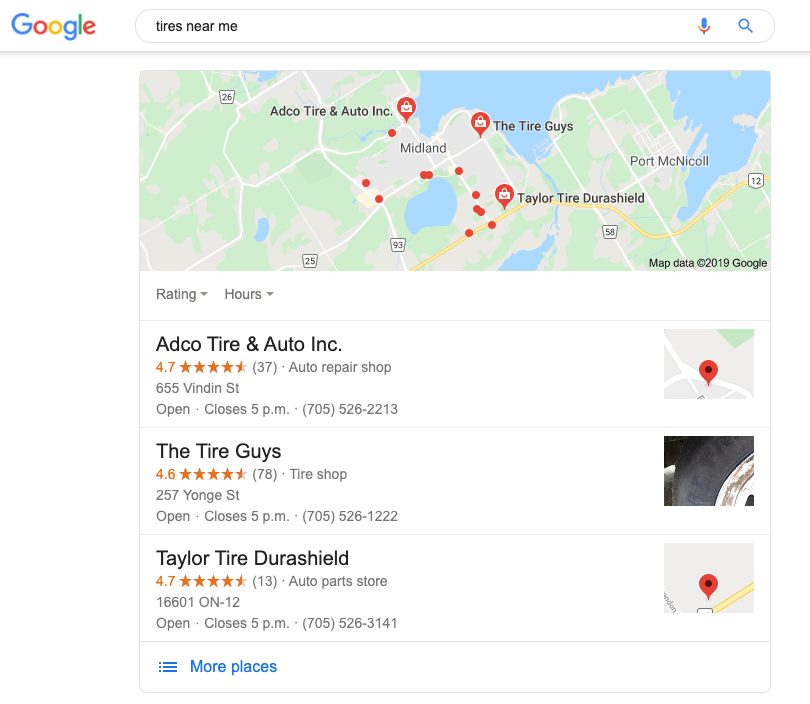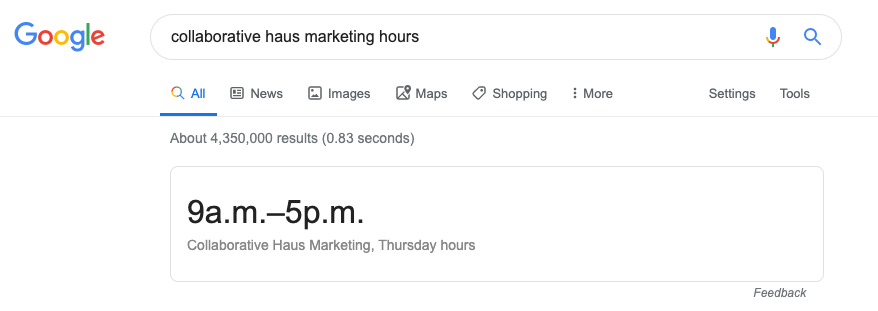Why ‘Near Me’ Searches Should Be Part of Your Businesses’ Local SEO Strategy
After presenting a keyword research report, clients often ask us what they should do with “near me” searches. You know the ones. Dentist near me, Pizza near me now, Awesome Marketing Company Near Me. The question always takes some form of this phrase: “How am I supposed to write “near me” in my website’s content?” The answer is…you don’t.
A keyword like “men’s running shoes” is easy to place in the written content on your site. But a term like “men’s running shoes near me” doesn’t really flow in the content. To rank for those “near me” terms, you can do other things that don’t involve writing clunky copy.
Before we get into those tips, here is why local SEO matters for your business.
The Importance of Near Me in Local SEO
If you rely on people visiting your business to buy a product or use your services, local SEO is crucial. The numbers back it up:
📈 46% of all searches on Google are seeking local information.
📈 88% of consumers who do a local mobile search will visit or call a store within a day.
Most users now have location or GPS enabled on their mobile devices. So when they look for something “near me”, search engines know exactly where they are and recommend nearby businesses.
Google and other search engines recognize the rising trend of local searches. People are all about “finding a specific thing, in a specific area, and in a specific period of time,” as Lisa Gevelber, VP of Marketing for the Americas at Google, puts it.
It’s why Google now presents you with a map with local businesses related to your “near me” query. It’s called ‘the local pack’ or ‘map pack’. It is important for your business to show up here when a term related to your business is searched. Being ranked in the top 3 is even better. You’ve probably seen it a thousand times, but here is what The Local Pack looks like:

Tires Near Me Google Search for Midland, ON
Here are 4 quick ways that you can improve your Local SEO and rank for near me searches, increasing the likelihood that searchers will find you on this map.
4 Tips For A Better Local SEO Strategy
1. Optimize Your Google My Business Listing
Your Google My Business (GMB) listing is THE cornerstone of your Local SEO strategy. There is a huge opportunity to stand out here, as 56% of local retailers haven’t even claimed their Google My Business listing. Just by claiming yours, you have an advantage!
Your GMB profile includes a host of information that you submit to Google. The services you offer, contact details, business description, category, and store hours are all pieces of information that you provide. There is also user-generated content, with Q&As and Google Reviews being the two popular ones.
Make sure that your GMB profile is as up-to-date and as accurate as possible. It increases your chance of appearing in the local pack and boosts your trustworthiness for users.
If you are looking for information on building your GMB, Google can help get you started (we can too).
Remember, Google isn’t the only search engine. Optimize your Bing Places and Apple Maps Connect too. This will give you coverage across the vast majority of local searches.
2. Optimize Your SEO Fundamentals
A few tweaks to some of the backend SEO content on your site can go a long way too. We’re talking about your URL, Title Tags, Headers, and Meta Description. By adding the keywords that your searchers are using to these elements (in a logical, user-friendly way), you will increase the likelihood of being found.
If you are not already adding blogs, you should consider it. Not only is it a way to share valuable content with your audience, but every new blog post is also an opportunity for adding some geographic-related content. Customer success stories and case studies are great opportunities to pair your product or service offering with your location.
3. Schema Markup
Schema Markup is like creating a treasure map of your site for search engines. It points search bots to specific parts of your website, allowing them to better understand location-based structured information like addresses, dates of events, phone numbers, and other information.
The Schema code allows search engines to present that location-based data in the form of rich snippets, which are immensely helpful for the user.
For example, if you wanted to look up our business hours on a Thursday, here is what schema allows Google to present the user:

Google Search for Collaborative Haus Marketing Hours
No extra clicks are needed. The user gets the information instantly.
For a complete guide to schema markup, Search Engine Journal has a fantastic resource.
4. A Mobile-friendly Site
The new reality of search engines is that most people are finding you on mobile, so it makes it obvious to optimize for mobile.
Google is in the business of providing its users with the best experience, so if most of their users are using mobile then you want to be mobile optimized.
Running your site past Google’s Mobile-Friendly Test will flag any causes for concern. Fix those concerns to make Google, and your searchers, happy.
Near Me Search Help Near You
All of these tips will improve the user experience of your site, thereby improving your rankings. With that said, it’s essential to remember that SEO is not stable, it is continually changing. You need to work for your rankings and work just as hard to maintain them – update existing content, adding new content, posting on social, acquiring backlinks, to name a few.
If you take anything away from this blog, it’s to go update your Google My Business Listing now. If you want to complete any of the above tips but are juggling a million other things, we are happy to help. From keyword research to optimizing content to schema markup – we can do all things SEO for your business. Contact us today – the first meeting is always free!





